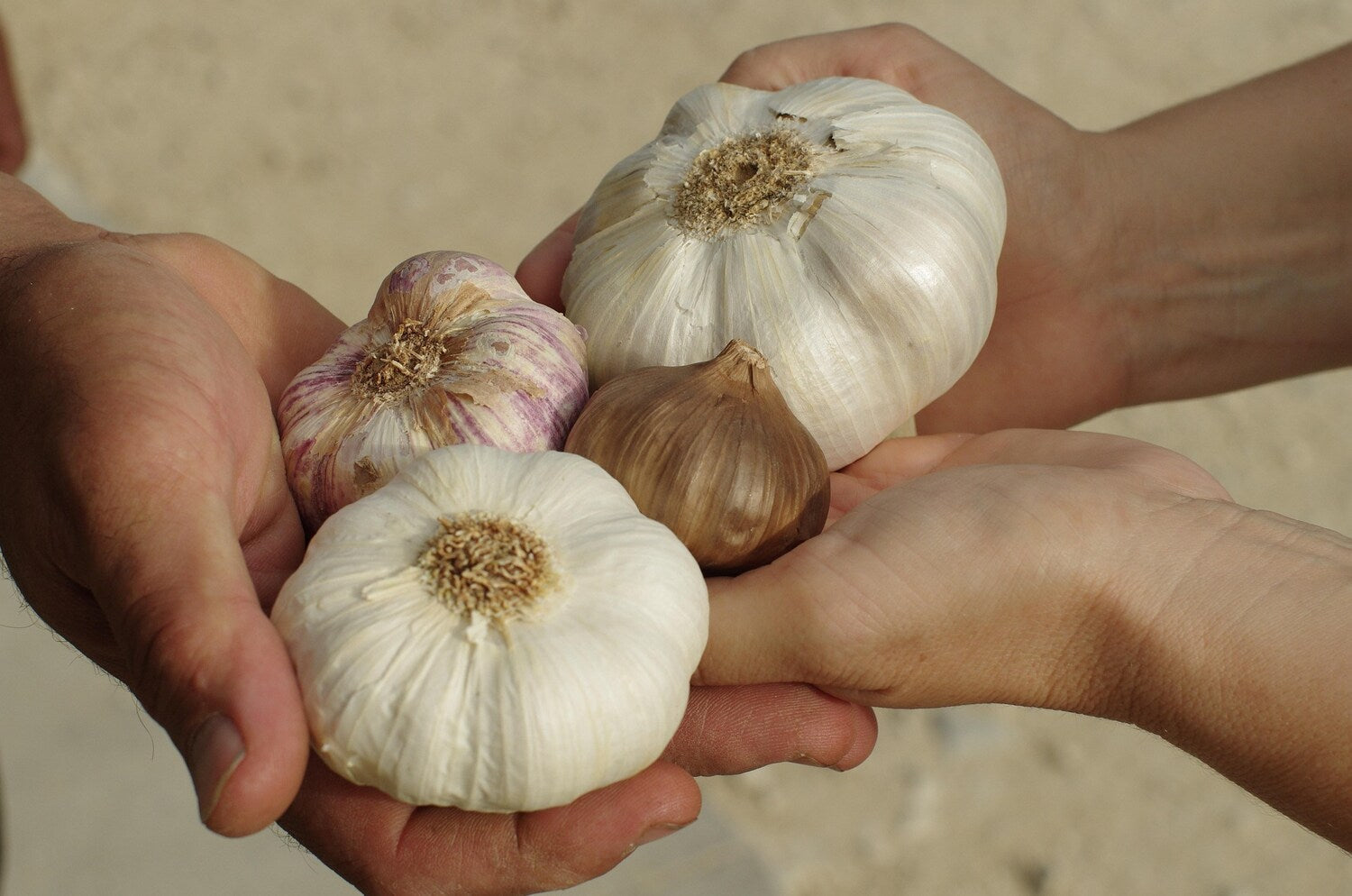As garlic farmers, we savor the unique qualities of homegrown garlic, but we also know consumers rely on readily available options. It’s important to understand the nuances of both growing and purchasing garlic. Explore the compelling benefits of growing garlic vs. buying it, so you can balance the dilemma of achieving superior freshness, cost savings, and accessibility.
Benefits of Growing Garlic vs. Buying It
Homegrown garlic offers fresh, controlled, and personally rewarding garlic production. In contrast, store-bought garlic offers unparalleled accessibility for those who lack the time, space, or inclination to garden. As you can see, both have compelling advantages.

Growing Garlic vs Buying It: General Overview
Choosing between growing garlic indoor at home and buying it from a store depends on your interest in gardening, your need for a steady supply, and your desire for fresh, flavorful garlic. Both methods have their pros and cons, including differences in taste, effort, and convenience.
Overview of Growing Garlic
Cultivating garlic involves planting individual cloves in the fall, allowing them to overwinter and develop into bulbs by the following summer. This process requires selecting the right variety for your climate, preparing well-draining soil, and providing adequate watering and care throughout the garlic growing season.
Overview of Buying Garlic
Purchasing garlic is a straightforward process of selecting bulbs from grocery stores, farmers' markets, or specialty shops, offering immediate access to this ingredient. This method requires no prior planning or gardening knowledge, providing convenience for cooks of different levels.
Comparing the Benefits of Buying Garlic and Growing Garlic
Comparing the benefits of buying versus planting garlic can help you make informed decisions about flavor, cost, control over quality, and personal satisfaction in sourcing this common culinary ingredient.
Similarities in the Benefits of Buying Garlic and Growing Garlic
Despite the distinct advantages of homegrown garlic, it's important to acknowledge the inherent benefits that both sources provide.
- Providing flavor to culinary dishes: Whether you’ve nurtured it from a clove or purchased it from the supermarket, garlic remains a culinary cornerstone, capable of transforming simple ingredients into flavorful meals.
- Rich in health-promoting compounds: Both homegrown and store-bought varieties contain allicin and other sulfur compounds linked to various health advantages, including supporting the immune system.
- Contributing to a well-stocked kitchen: Having garlic readily available, whether hanging in braids from your garden harvest or stored in your pantry, is vital for any well-equipped kitchen.
- Supporting businesses and economies: Buying garlic helps increase local farmers' profits, distributors, and retailers, while growing your own can stimulate local economies through the purchase of supplies and the potential for selling surplus.

Differences in the Benefits of Buying Garlic and Growing Garlic
The distinctions between buying and planting garlic highlight the unique advantages each option presents.
1. Flavor Intensity and Aromatic Profile
Freshly harvested homegrown garlic often possesses a more intense and nuanced flavor profile compared to store-bought garlic that has undergone storage and transportation. Most store-bought garlic has been harvested months before you buy it. It's dried to last longer, so the flavor may fade over time.
2. Control Over Growing Methods and Potential Residues
Gardeners can choose organic methods, keeping their garlic free from synthetic chemicals, a level of control not afforded when purchasing from commercial sources.
3. Upfront Costs and Long-Term Savings
While buying garlic involves consistent, albeit often small, expenditures, planting garlic requires an initial investment that can lead to significant long-term savings through repeated harvests. Meanwhile, buying garlic is quick and simple, as most garlic cloves cost only a little money at the grocery store.
4. Personal Satisfaction and Connection to Nature
The intangible rewards and well-being benefits of gardening, the connection to the earth, and the pride in harvesting your own food are unique benefits of growing garlic that are absent when simply purchasing it.
5. Variety and Availability Beyond Standard Store Offerings
Home gardeners have access to a much wider array of garlic varieties than what is typically found in grocery stores. Exploring these diverse cultivars makes way for a richer culinary experience, with varying flavor profiles, sizes, and storage capabilities.
When Should I Grow Garlic?
Here are specific situations where it's more practical to grow garlic:
- You prioritize intense and nuanced flavor.
- You want control over growing methods.
- You are a frequent garlic user seeking long-term savings.
- You enjoy gardening and the satisfaction of self-sufficiency.
When Should I Buy Garlic?
Here are the situations where it would be more beneficial to buy garlic.

- You need garlic immediately.
- You have limited gardening space or time.
- You only use garlic occasionally in small amounts.
- You are traveling or don't have a stable location for gardening.
Which Method of Getting Garlic Should I Use?
When deciding between growing your own garlic and buying it, a mix of both methods can be smart. You can buy common garlic for daily use and experiment with growing unique varieties in your garden. This way, you get convenience and still enjoy the rewards of home gardening.
|
Factor |
Growing Garlic |
Buying Garlic |
|
Taste and variety |
High control, many types available |
Limited choices |
|
Cost |
Higher at first, lower over time |
Lower at first, quickly adds up |
|
Time and accessibility |
Needs months to mature, regular care |
Immediate and readily available |
|
Space |
Requires a garden or containers |
Small space in the pantry |
|
Quality and safety |
Full control, pesticide-free, if possible |
Dependent on store practices |
Related Questions
What Are the Disadvantages of Buying Garlic?
Store-bought garlic may lack freshness and flavor compared to homegrown varieties, and commercially grown garlic is often treated with chemicals to prevent sprouting. You can solve this by purchasing organic garlic from local farmers' markets or growing your own garlic at home.
What Are the Downsides of Planting Garlic?
Planting garlic requires patience as it takes eight to nine months from planting to harvest, and plants can be susceptible to diseases and pests. These issues can be mitigated by practicing crop rotation, using disease-free seed garlic, and maintaining proper soil drainage.
What Are Easy-to-Grow Garlic Varieties for Beginner Gardeners?
Softneck varieties, such as Organic Chet's Italian Red and Inchelium Red, are excellent choices for beginners, as they're adaptable to various climates and have good storage potential. Hardneck varieties, such as Music and German Red, are also beginner-friendly options due to their hardiness and rich flavor profiles.
Conclusion
Fresh homegrown garlic often tastes stronger and keeps its flavor longer after harvest. Buying garlic is convenient, especially if you didn’t plant your own or want to try types not grown locally. Consider planting garlic cloves yourself to experience the satisfaction of harvesting your own garlic crops, while keeping store-bought garlic as a convenient option for time or space constraints.


